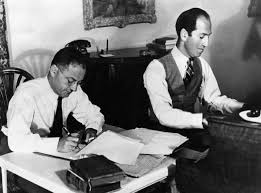TODAY WAS A FAERIE TALE
In 1917, two little girls tricked the world into believing fairies were real. Even the creator of Sherlock Holmes, the most unassailably logical human ever to exist, fictionality be damned - believed the girls. But the question is not why did two little girls play the trick, but why adults so eagerly believed two little girls. The answer is simply sometimes the desire to believe in something overtakes logic.
To begin our fairy tale we go back to two other teen girls I've covered - the Fox Sisters. Their little prank of saying they could speak to the dead validated the emerging religion of spiritualism. Spiritualism was a whole cloth ideal that people could speak to the dead ; Theosophy, Spiritualism's offspring, saw the whole cloth and how it could be cut down to actually make something. Theosophy was logic applied to belief. You could believe people can talk to the dead, but something like spirit photography, with a technological element, could be analyzed and disproved. Theosophy was a natural response to industrialization. With technology rapidly changing everyday life, and science answering age old questions more easily than ever, there seemed to be less magic to believe in. Theosophy moved away from the spiritual into the natural, and photography, used to disprove a part of spiritualism, ironically could be used to prove certain aspects of theosophy.
In 1917 Annie Griffiths and her 9 year old daughter Frances went to stay with family as Mr Griffiths was fighting in World War I. The Wright family - Polly, Arthur and 16 year old Elsie took them in. Cottingley was a village in the English countryside, quiet and quaint. A beck - a stone bedded creek - ran along the side of the Wright's home. The girls often came home wet and muddy after playing in the beck, to their mothers' dismay. Their excuse - faries. Yes mums, we see fairies in the beck. Arthur, skeptical, entrusted the girls with his camera and said he would develop the photos in his dark room. Sure enough the girls emerged on the photo plates frolicking with fairies. Their mothers, both Theosophists, were ecstatic, but had no idea the four year media sensation they were about to embark on.
In 1919 Polly Wright took the photos to a Theosophical Society lecture on the life of fairies. The photos made their way to Edward Gardner, head of the Theosophical Society. He showed the photos to Sir Arthur Conan Doyle and Doyle beseeched Gardner to investigate. Gardner saw the photos as a golden opportunity. Photos of fairies frolicking with innocent young girls would be an excellent way to promote Theosophy. Young girls are too innocent to lie, therefore the photos must be real, therefore Theosphy is valid.
Gardner visited the Wright home, but the girls demured when he wanted to see the fairies. Gardner gave the girls a camera (with possibly marked photo plates) and asked them to take new photos. They do so, and Arthur Wright developed them immediately. Again girls + fairies = proof. Gardner took the new photos to Sir Arthur Conan Doyle. Doyle published the photos, along with an article purporting the existence of fairies in the Christmas issue of The Strand. The issue sold out in two days as fairy mania took hold.
For two years the photos were examined, heralded, and derided. Skeptics said the fairies looked flat, paper like and cast no shadow. One fairy did not have wings. The Theosophical Society had the photo plates examined by a photo expert from Kodak, who proclaimed the photo plates had not been altered. Five Cottingley Photos were taken from 1917 to 1920 :
Fairies In Their Sun Bath (1920)
The fairy phenomenon became forgotten by 1921 as England began to feel the aftermath of world war I.
Elsie and Frances grew up, married, lived abroad, but settled back in England. The girls made a pact never to disclose any secrets they kept about the fairies or the photos. In 1978 James Randi, stage magician and skeptic, challenged the validity of the photos. Interest in the Cottingley Fairies was revived, and in the early 1980s Frances and Elsie, now elderly, revealed the fairies were illustrations traced from a children's book (ironically featuring a story by Sir Arthur Conan Doyle.) When asked why they pulled their childish prank the cousins said they were tired of adults believing children didn't know anything. They didn't mean for their prank to spiral out of control, and felt badly that Mr. Gardner and Mr Doyle, both nice men, would have been humiliated if they had confessed. Like Maggie and Katie Fox adults took a story from children and ran with it, proclaiming truth without an examination of facts. Frances told a reporter that the entire time the photos were popular no one ever asked why only she and Elsie could see the fairies. The girl said adults wanted to believe, so they did. In a world of science and technology moving faster than human comprehension, and a devastating world war, who wouldn't want a little fairy magic?









Comments
Post a Comment